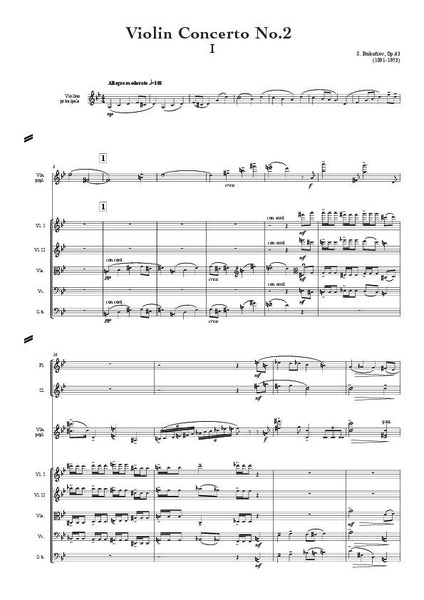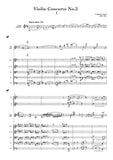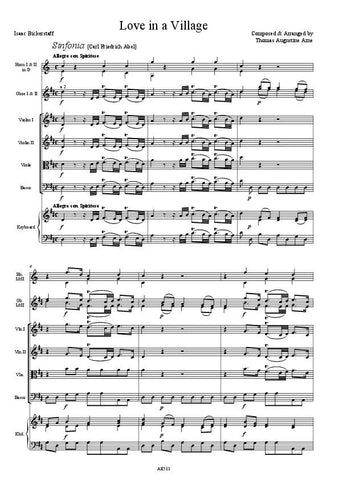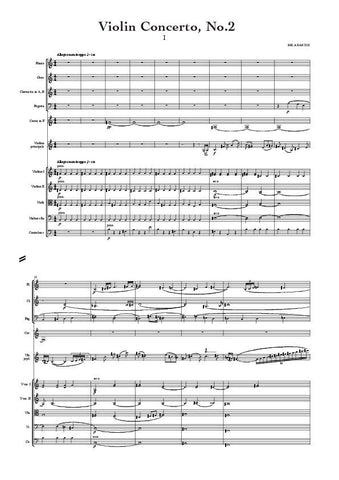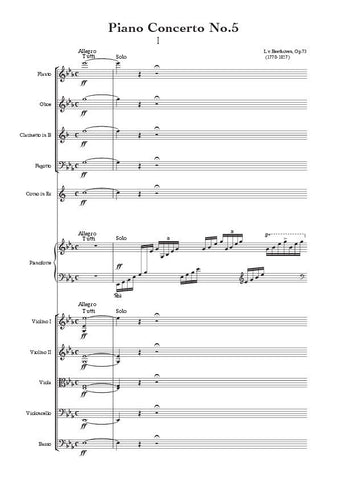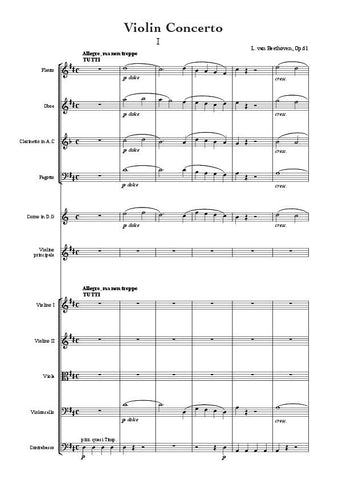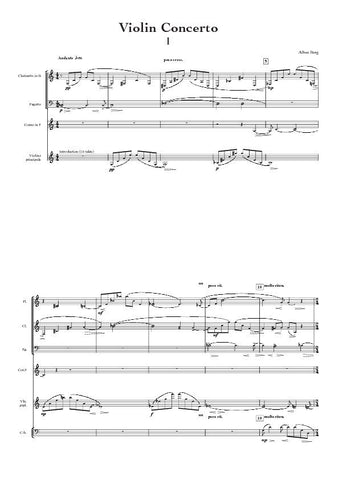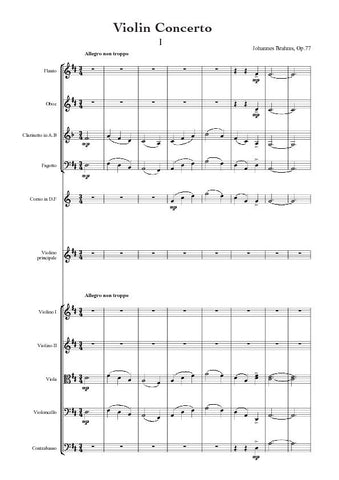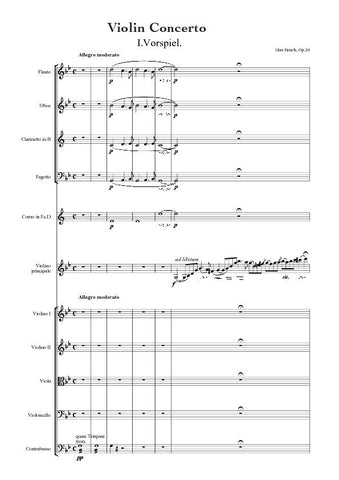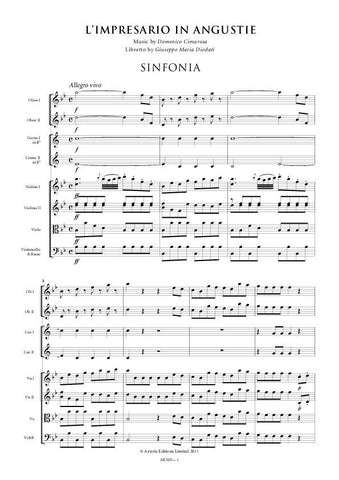Description |
Prokofiev, Sergei (1891-1953)
|
||||||||||||||||
Details |
Artaria Editions is very pleased to introduce a new concept to the study and performance of standard repertoire concertos. Arranged for soloist and chamber ensemble, typically consisting of a quintet of wind players and a string quintet, these new arrangements provide soloists with an opportunity to rehearse and perform major repertoire under conditions closely resembling a full orchestral setting. They provide valuable practice for small ensembles to work with soloists and an ideal vehicle for student conductors to work with major solo repertoire. Sergey Prokofiev was born in 1891 at Sontsovka in the Ukraine, the son of a prosperous estate manager. An only child, his musical talents were fostered by his mother, a cultured amateur pianist, and he tried his hand at composition the age of five, later being tutored at home by the composer Glière. In 1904, on the advice of Glazunov, his parents allowed him to enter the St Petersburg Conservatory, where he continued his studies as a pianist and as a composer until 1914, owing more to the influence of senior fellow students Asafyev and Myaskovsky than to the older generation of teachers, represented by Lyadov and Rimsky-Korsakov. Even as a student Prokofiev had begun to make his mark as a composer, arousing enthusiasm and hostility in equal measure, and inducing Glazunov, now director of the Conservatory, to walk out of a performance of The Scythian Suite, fearing for his sense of hearing. During the war he gained exemption from military service by enrolling as an organ student and after the Revolution was given permission to travel abroad, at first to America, taking with him the scores of The Scythian Suite, arranged from a ballet originally commissioned by Dyagilev, the Classical Symphony and his first Violin Concerto. Unlike Stravinsky and Rachmaninov, Prokofiev had left Russia with official permission and with the idea of returning home sooner or later. His stay in the United States of America was at first successful. He appeared as a solo pianist and wrote the opera The Love for Three Oranges for the Chicago Opera. By 1920, however, he had begun to find life more difficult and moved to Paris, where he re-established contact with Dyagilev, for whom he revised The Tale of the Buffoon, a ballet successfully mounted in 1921. He spent much of the next sixteen years in France, returning from time to time to Russia, where his music was still acceptable. In 1936 Prokofiev decided to settle once more in his native country, taking up residence in Moscow in time for the first official onslaught on music that did not sort well with the political and social aims of the government, aimed in particular at the hitherto successful opera A Lady Macbeth of the Mtsensk District by Shostakovich. Twelve years later the name of Prokofiev was to be openly joined with that of Shostakovich in an even more explicit condemnation of formalism, with particular reference now to Prokofiev's opera War and Peace. He died in 1953 on the same day as Joseph Stalin, and thus never benefitted from the subsequent relaxation in official policy to the arts. As a composer Prokofiev was prolific. His operas include the remarkable The Fiery Angel, first performed in its entirety in Paris the year after his death, with ballet-scores in Russia for Romeo and Juliet and Cinderella. The last of his seven symphonies was completed in 1952, the year of his unfinished sixth piano concerto. His piano sonatas form an important addition to the repertoire, in addition to his songs and chamber music, film-scores and much else, some works overtly serving the purposes of the state. In style, his music is often astringent in harmony, but with a characteristically Russian turn of melody and, whatever Shostakovich may have thought of it, a certain idiosyncratic gift for orchestration that gives his instrumental music a particular piquancy. The Violin Concerto No. 2 in G minor, Opus 63, was written in 1935, commissioned by a group of French admirers for the use of the violinist Robert Soetens. Prokofiev later explained the diverse circumstances of its composition, making use of material that he had put together before. He had at first envisaged a concerto-sonata for violin and orchestra, seeking, in his new desire for simplicity, something different from the earlier concerto, but eventually returned to the conventional title of concerto. He was, at the time, travelling widely, and describes how this is reflected in the circumstances of composition of the concerto, the principal theme of its first movement written in Paris and of the second movement in Voronezh, with the orchestration completed in Baku and the first performance given in Madrid in December 1935, during a tour of the Iberian peninsula and North Africa with Soetens. The concerto starts with the unaccompanied solo entry, echoed by the violas and double basses, and later resumed in initial canon between lower strings and the soloist. A faster-moving passage leads now to a second even more lyrical subject, marked meno mosso and echoed briefly by the French horns and woodwind. The central development starts with a brief dialogue between the soloist, the violas and the first violins, before carrying forward the first subject and elaborating the more tranquil second theme. The recapitulation, in a movement built on tripartite classical principles, is introduced by cellos and double basses, to which the solo violin adds its own derivative of the theme. Insistent rhythms are followed by the re-appearance of the major key second subject, but it is the original minor key and opening theme that ends the movement. Plucked strings and clarinets start the second movement in a gentle 12/8 metre, contrasted with the cross-rhythm of the lyrical solo theme. A passage of greater rapidity and changing tonalities leads to the return of the principal E flat theme, now in C major. Other thematic material and changing moods and keys intervene, before the final return to the principal theme, preceded by a curious passage for solo violin, in double-stops, together with violas and cellos, in dialogue with the bassoons. In conclusion the soloist adds a plucked accompaniment to the theme. A more characteristically percussive element marks the opening of the final Allegro, with a first contrasting episode in 7/4 and a second episode played in a higher register on the lowest string of the violin. After further use of the material introduced, it is the principal theme that leads forward to the coda and brilliant conclusion. |
Loading...
Error




